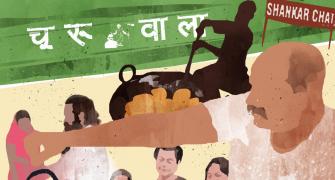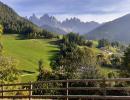
Umpteen cheese shops, selling gorgeous golden wheels of Gouda cheese, is one of the first sights of Amsterdam.
Sold in many imaginative and sometimes rather pricey flavours -- lavender, truffle, whiskey, red/green pesto, black garlic, coconut, honey and thyme, rosemary, beer, cumin -- they sure get the digestive juices going.

Holland, because of its all-year rainy climate that provides loads of green grass for its cows, is, of course, known for its creamy, not-too-smelly lovely mild cheeses. Amsterdam is too, as one of the enormous ports closest to the centres of kaas (cheese) wholesaling.

But Amsterdam should also be known -- in addition to cheese stores, gently-flowing canals, attractive grachtenpand (the metro's legendary slim, tall dwellings overlooking the waterways), tulip shops, Anne Frank's house -- for its silence.
Bicycles are infinitely more numerous on the streets/quarter around the canals than cars, and with it comes the blissful, godsent decrease in traffic sounds. The boats too run on lithium battery-powered electric motors and glide about silently. So do the trams and quite a few of the mini cars, that fit one-and-a-half people.
Giving back to the environment through rigid recycling, converting motors to electric etc is usually expensive business, so that silence is costly, but oh so wonderful.

As you stand and gaze at the pretty homes and marvel at how an urban space has been converted into such a place of beauty, you are completely enthralled by the quietness, which lends an air of old-fashioned calm and is quite representative of cultural and environmental wokeness of the Dutch.

I was returning to Amsterdam after exactly 30 years and was fortunate that the KLM flight I took to Dublin, to visit my elder daughter, afforded this eight-and-a-half serendipitous stopover, both ways, in The Netherlands' 'Sin City'.
I was also lucky that I made a decision to take a ride on one of Amsterdam's tour boats again. It's a very touristy thing to do, but actually efficiently covers the loveliest parts of the city in 75 minutes and reacquainted me with the bits and pieces I had explored three decades ago (then four months pregnant).

Not that much had changed since 1994. It's still a city of flowers, art and still waters running deep. The central canal quarter is dotted with even trendier cafes, bars, boutiques, galleries. A few Palestine flags firecely waved about. A larger variety of cannabis treats were selling than before.

Tourist numbers were certainly tremendously up. And there were restrictions on how many people can, for instance, buy tickets to enter the Van Gogh Museum and Anne Frank House or browse The Lego Store for gifts.
Pedestrian shopping street Kalverstraat, off Dam Square, bustled with roaming tourists of more nationalities than you could find at the UN or Heathrow airport.

Plastic bags were no longer available in any shop. Only paper. It was raining heavily, sporadically, and the Mumbai Duty Free bag that contained all my earthly possessions for this day outing (that was drawing curious Indian eyes) fell apart in the first downpour and it was difficult to find anything to replace it.

My tour boat trip familiarised me, courtesy the tour guide-captain, with so many interesting historical facts and quirky details about 10th century-founded Amsterdam, whose most celebrated residents have been Baruch Spinoza, Rene Descartes, Rembrandt van Rijn, Vincent van Gogh, Anne Frank, Mata Hari, Eddie Van Halen, Johan Cruyff, and was once a centre for Protestant pilgrims after the Mirakel van Amsterdam (a miracle that saw a dying man recover). Folks like Mick Jagger, Yotam Ottolenghi, Steve McQueen, Peter the Great also own/owned homes there too.
I provide the most intriguing of those nuggets of info I learned that day, here, that will hopefully spur you onto visiting the must-see Dutch city that sets a global example as tremendously environmentally-friendly city:

- Amsterdam was a huge trading metropolis right from the Middle Ages that grew incredibly wealthy through its Hanseatic league (mediaeval version of NATO) commercial connections. It was a city of merchants and therefore its canal houses had a deep, narrow but tall design so goods could be stored in the attics and then hoisted down by pulleys to be transported, wherever they were headed, by boat.

- Much of the Amsterdam burghers' wealth of the 1700s -- that made Amsterdam the richest city of Europe, with the first stock exchange in the world -- came from the goods it imported from Dutch East India Company and the Dutch West India Company like cocoa, spices, cotton, silk, porcelain, silver, tobacco, slaves, animal skins, tea, wine, sugar, grain, cochineal, livestock and more.
- The second largest population of the Indian Diaspora in Europe lives in Amsterdam and Holland -- one of whom was Rattan Chadha who began clothing brand Mexx. Some of them belonged to the Indian Diaspora of the once Dutch colony Suriname and had moved to The Netherlands.

- The 165-canal network (larger than Venice), that stretches 100 km, has three main historic neighbourhoods of canals, of tourist interest, differing in wealth -- Herengracht, Prinsengracht, Keizersgracht -- that form concentric rings in the centre of the city.
The gabled residences are the fanciest and classiest in Keizersgracht and Herengracht and are less narrow; their beautiful exteriors conceal exquisite inside courtyard gardens. - Like toy houses, the tinier Amsterdam canal homes can often be just 18 feet across or less.
- Today the canal houses of Amsterdam are some of the most high-priced properties in Europe, selling for several million euros a piece. So expensive are they, that many of them were empty at night, because they serve as office space for embassies, multinationals and high-end businesses, haute couturiers that could afford such steep real estate.

- Living on any of the city's 2,500 picturesque houseboats is not any cheaper, because of the exorbitant cost of the limited ligplaats or license to dock and locals call these moneyed, boat-inhabiting folks wateryuppies.
Renting or buying a boat on the canals might seem a fun way to live, except one small problem -- over 150 tour boats take a huge chunk of Amsterdam's 15.1 million yearly tourists through the canals and everyone loves to gawk into a houseboat.
Also, the vessels are pretty cold to hunker down in, in the winter and rather stuffy in summer. There is a houseboat museum located on one of the inner canals.

- Amsterdam's 1,200 bridges, especially the quaint drawbridges like the prominent Mager Brug or Skinny Bridge, also offer unique character to this mega town.

- Some 880,000 bicycles are owned by Amsterdammers and they have access to 515 km of bike lanes. Many of them -- a whopping 12,000 a year -- fall into the canals and 'drown' and bicycle fishing is a pastime (that sometimes brings up fridges, safes and shopping carts also).
Cars too once met their watery end, frequently, in the canals, when folks forgot to apply their handbrakes, but then insurance companies (tired of paying out huge premiums) got together and installed a neat unobtrusive guard rail on the perimeter of the canals around Amsterdam.
Now only one car a week, carelessly driven, dives in, jumping the guard rail.
Inebriated, urinating men, out for a 'wild wee', were another casualty, until the city kindly installed little grablines and ladders for the men to hang onto, till rescued.

- The canals have a special Bubble Barrier system, fitted in 2019, to collect and filter plastic waste.
- Some winters the canals freeze over and ice skating is another quiet way of getting from one part of the city to another.

- One of Amsterdam's fanciest hotels, the Waldorf Astoria occupies a whole canal block, built across six 17th and 18th century palatial canal homes in Herengracht and the waiting list is apparently endless for rooms at this hotel, where tariffs begin upwards of 800 euros a night.
This was Taylor Swift's address during her recent stop in Amsterdam as part of her one-and-a-half-year Eras Tour. - Amsterdam is famed for its markets that dot certain sections of the canals or are a stone's throw away -- a floating flower market, a well-known antique market, cheese and organic produce markets, a Friday book market, a Sunday art market.

- The Holocaust took away some three-fourths of Amsterdam's Jewish population, along with dear little Anne Frank.
This historic city once had a thriving Jewish population, who in the 1700s chose secular Holland and Amsterdam, known for its religious tolerance, to settle down in, because it afforded them the freedom to practice their beliefs and they became the backbone of the local merchant community.

There are loads of interesting food to be sampled in Amsterdam when you are done munching on samples of cheese :)).
Delicious stroopwafels, the creamy Tompouce cake and pancakes are famous city fare. So is its herring, Bitterballen (fried meatballs) and Snert or pea soup
Amsterdam has loads of vegetarian fare available -- pastas, sandwiches, salads.
Since time was running out, I popped in at a random restaurant near Begijnhof (close to an ancient women's presbytery) named Onze Zaak (Our Affair) and was quite delighted with the Italian-accented food.
The handmade ravioli, stuffed with ricotta and fresh nettle, finished with lemon butter noisette (browned butter) and grated mimolette (a dark orange Edam type cheese) was delicious.
But it was the dessert that blew me away.
The gentleman serving me suggested I try the Sous Vide Rhubarb that was on the menu that day. I am not usually very experimental, but bravely decided to give the Carrot Banana Cake, Affogato (vanilla ice cream with espresso) and the Dark Chocolate Candy Bar, made with toffee caramel and pista ice cream, a pass, to try this rhubarb wonder that he suggested. An intriguing dessert with several layers of flavour, it was made with thickened yoghurt, lychee sorbet, raspberry gel, fresh currants, rhubarb, fresh fennel greens... And was yum. Except for the sorbet, it was more like a yoghurt parfait and is an ideal breakfast too.
Here is my recreated version, substituting lemon sorbet for lychee sorbet and rhubarb with frozen and fresh raspberries and sour cherries (since that is the closest in tartness), which I served with raspberry crush, a crumbled granola bar and mint instead of fennel.

Amsterdam-Style Fruit-Yoghurt-Sorbet Dessert
Serves: 1
Ingredients
- 1 handful frozen or fresh raspberries, available at stores selling frozen foods
- 4-5 fresh cherries, deseeded, chopped
- 3-4 dried cranberries, soaked in water
- 100 ml yoghurt sweetened with honey
- 2 tbsp raspberry crush, like Mapro’s
- 2-3 fresh mint leaves
- 2 tsp crumbled granola or crumbled granola bar
- 1 scoop lemon sorbet
Method
- In a single-serving dessert bowl, add a layer of sweetened yoghurt and dab with the 2 tbsp raspberry crush.
Sprinkle the cherries, raspberries and drained cranberries.
Add a scoop of lemon sorbet.
Sprinkle with the crumbled granola and garnish with the mint leaves. - Serve immediately.
Zelda's Note: I chose to use raspberries and cherries but other seasonal fruits will work just as well like mango chunks, fresh blueberries, pomegranate.
You can make your own fruit sorbet: Sieve 100 gm of any ripe fruit -- like mangoes, peaches, plums, strawberries, cherries, pulped lychees -- into a bowl and keep aside.
Warm ¾ cup water with 1/3 cup icing sugar or several tbsp honey, in a saucepan over low heat, till it dissolves and then cool. Add the juice of 1 neebu or lime or 1 orange to the cooled syrup.
Mix the syrup with the fruit and pour the mixture in a shallow freezing tray and freeze about 45 minutes or till it has begun to thicken.
Empty the thickened liquid into a chilled bowl and whisk about 5 minutes vigorously and return to the tray and freeze another 2-3 hours.
Or use Rediff Food's recipe for Champagne Sorbet.










